Unilever's Business Operations: A Deep Dive into Key Strategies
VerifiedAdded on 2023/06/13
|9
|2579
|322
Case Study
AI Summary
This case study provides an overview of Unilever's business operations, focusing on its supply chain management, human resource strategies, and quality control processes. The report highlights Unilever's commitment to sustainable sourcing of raw materials, efficient manufacturing processes, and a robust distribution system. It examines HR strategies such as purposeful hiring, frequent communication, growth opportunities, and comprehensive benefits packages. The quality control process is detailed, emphasizing the importance of setting quality standards, focusing on key measures, optimizing operational processes, reviewing results, using measurable feedback, and making continuous improvements. The analysis concludes that Unilever's differentiated supply chain management and innovative approaches contribute to its business growth and success in the global market. Desklib offers a variety of solved assignments and study resources for students.
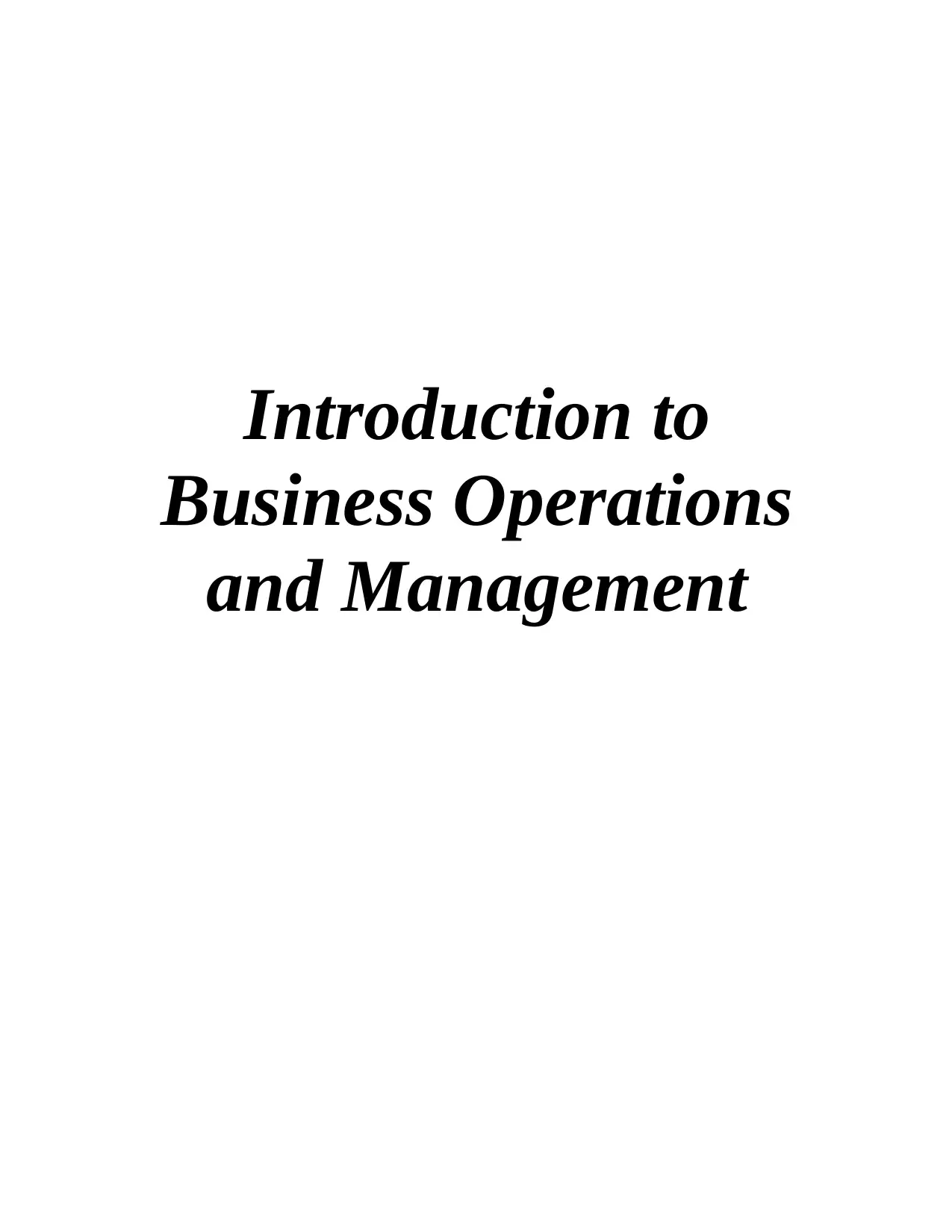
Introduction to
Business Operations
and Management
Business Operations
and Management
Paraphrase This Document
Need a fresh take? Get an instant paraphrase of this document with our AI Paraphraser
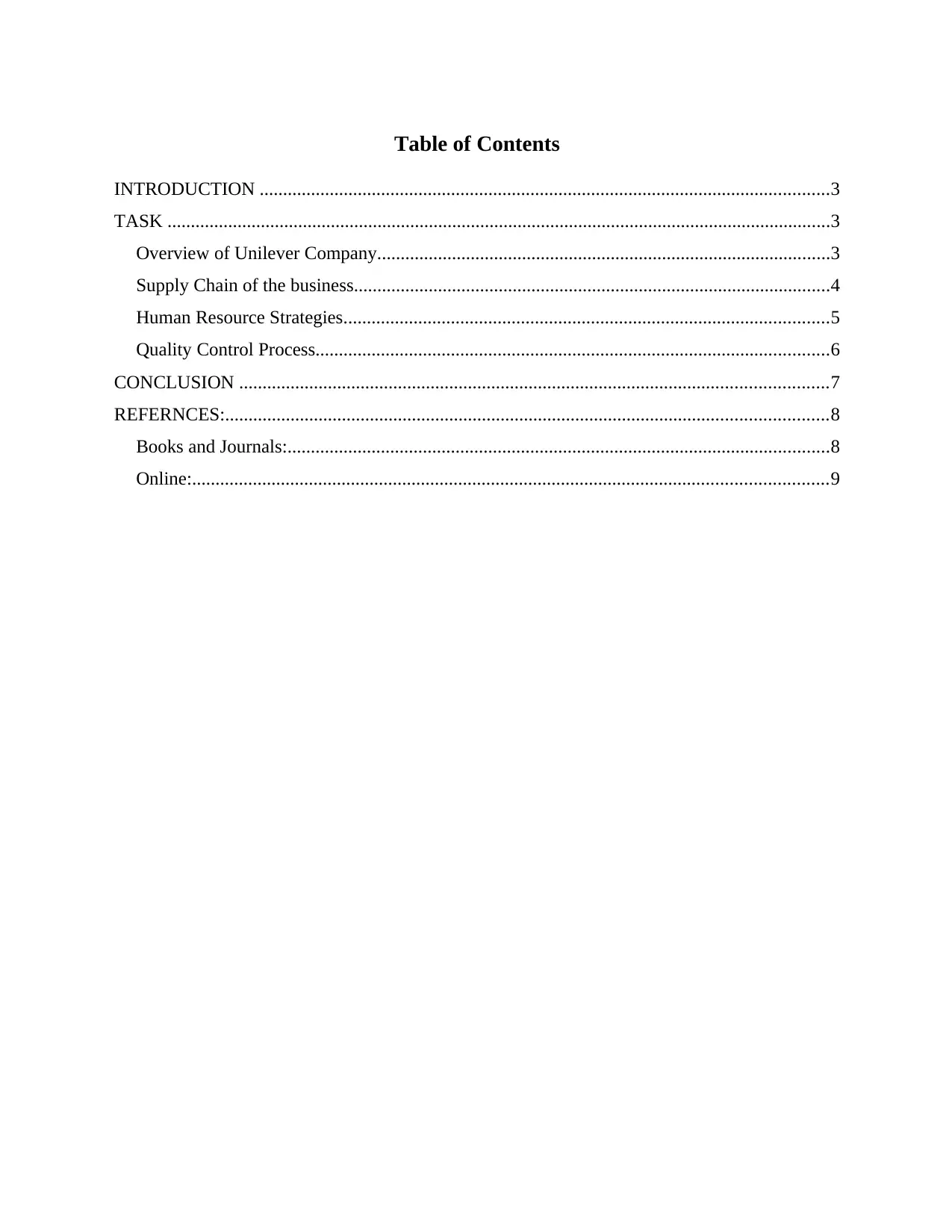
Table of Contents
INTRODUCTION ..........................................................................................................................3
TASK ..............................................................................................................................................3
Overview of Unilever Company.................................................................................................3
Supply Chain of the business......................................................................................................4
Human Resource Strategies........................................................................................................5
Quality Control Process..............................................................................................................6
CONCLUSION ..............................................................................................................................7
REFERNCES:.................................................................................................................................8
Books and Journals:....................................................................................................................8
Online:........................................................................................................................................9
INTRODUCTION ..........................................................................................................................3
TASK ..............................................................................................................................................3
Overview of Unilever Company.................................................................................................3
Supply Chain of the business......................................................................................................4
Human Resource Strategies........................................................................................................5
Quality Control Process..............................................................................................................6
CONCLUSION ..............................................................................................................................7
REFERNCES:.................................................................................................................................8
Books and Journals:....................................................................................................................8
Online:........................................................................................................................................9
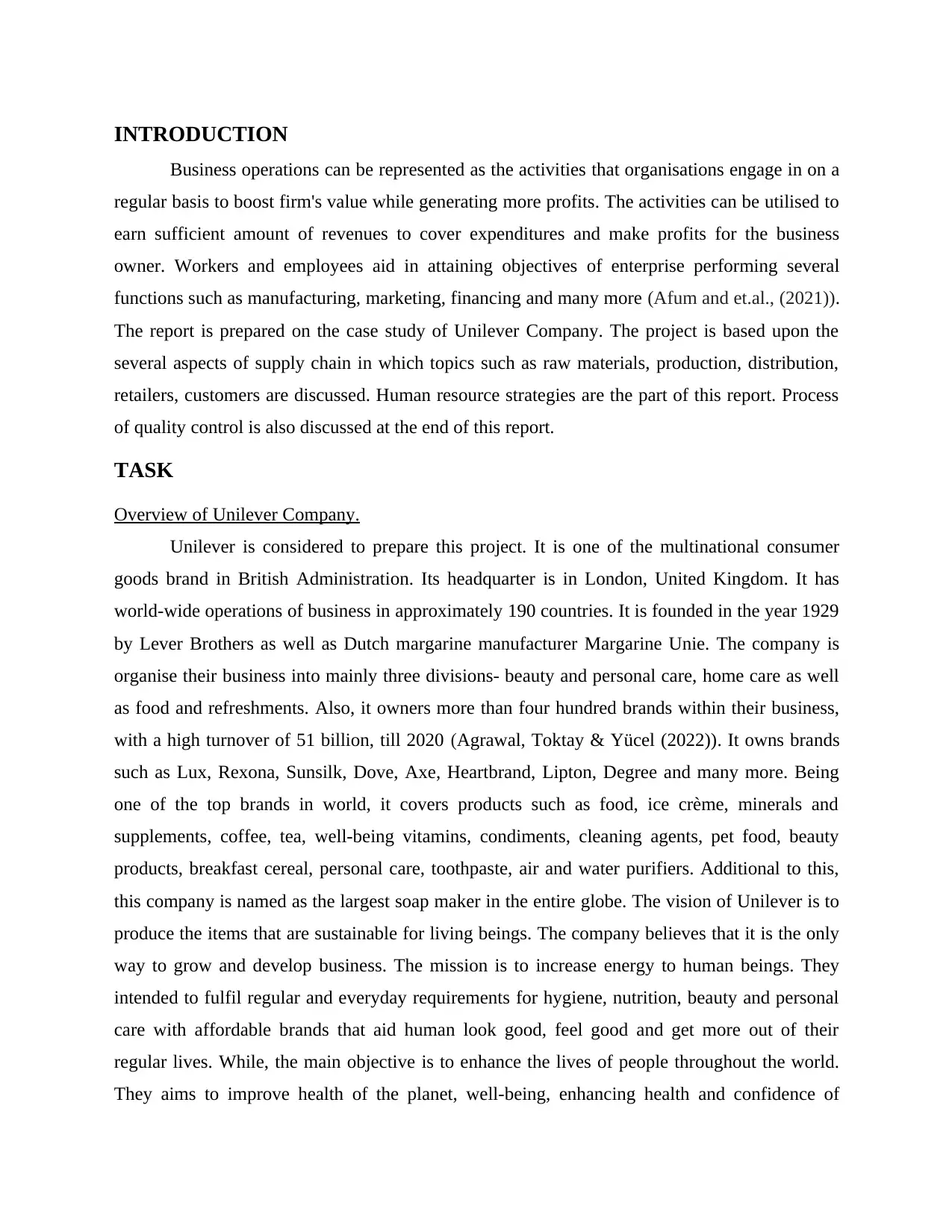
INTRODUCTION
Business operations can be represented as the activities that organisations engage in on a
regular basis to boost firm's value while generating more profits. The activities can be utilised to
earn sufficient amount of revenues to cover expenditures and make profits for the business
owner. Workers and employees aid in attaining objectives of enterprise performing several
functions such as manufacturing, marketing, financing and many more (Afum and et.al., (2021)).
The report is prepared on the case study of Unilever Company. The project is based upon the
several aspects of supply chain in which topics such as raw materials, production, distribution,
retailers, customers are discussed. Human resource strategies are the part of this report. Process
of quality control is also discussed at the end of this report.
TASK
Overview of Unilever Company.
Unilever is considered to prepare this project. It is one of the multinational consumer
goods brand in British Administration. Its headquarter is in London, United Kingdom. It has
world-wide operations of business in approximately 190 countries. It is founded in the year 1929
by Lever Brothers as well as Dutch margarine manufacturer Margarine Unie. The company is
organise their business into mainly three divisions- beauty and personal care, home care as well
as food and refreshments. Also, it owners more than four hundred brands within their business,
with a high turnover of 51 billion, till 2020 (Agrawal, Toktay & Yücel (2022)). It owns brands
such as Lux, Rexona, Sunsilk, Dove, Axe, Heartbrand, Lipton, Degree and many more. Being
one of the top brands in world, it covers products such as food, ice crème, minerals and
supplements, coffee, tea, well-being vitamins, condiments, cleaning agents, pet food, beauty
products, breakfast cereal, personal care, toothpaste, air and water purifiers. Additional to this,
this company is named as the largest soap maker in the entire globe. The vision of Unilever is to
produce the items that are sustainable for living beings. The company believes that it is the only
way to grow and develop business. The mission is to increase energy to human beings. They
intended to fulfil regular and everyday requirements for hygiene, nutrition, beauty and personal
care with affordable brands that aid human look good, feel good and get more out of their
regular lives. While, the main objective is to enhance the lives of people throughout the world.
They aims to improve health of the planet, well-being, enhancing health and confidence of
Business operations can be represented as the activities that organisations engage in on a
regular basis to boost firm's value while generating more profits. The activities can be utilised to
earn sufficient amount of revenues to cover expenditures and make profits for the business
owner. Workers and employees aid in attaining objectives of enterprise performing several
functions such as manufacturing, marketing, financing and many more (Afum and et.al., (2021)).
The report is prepared on the case study of Unilever Company. The project is based upon the
several aspects of supply chain in which topics such as raw materials, production, distribution,
retailers, customers are discussed. Human resource strategies are the part of this report. Process
of quality control is also discussed at the end of this report.
TASK
Overview of Unilever Company.
Unilever is considered to prepare this project. It is one of the multinational consumer
goods brand in British Administration. Its headquarter is in London, United Kingdom. It has
world-wide operations of business in approximately 190 countries. It is founded in the year 1929
by Lever Brothers as well as Dutch margarine manufacturer Margarine Unie. The company is
organise their business into mainly three divisions- beauty and personal care, home care as well
as food and refreshments. Also, it owners more than four hundred brands within their business,
with a high turnover of 51 billion, till 2020 (Agrawal, Toktay & Yücel (2022)). It owns brands
such as Lux, Rexona, Sunsilk, Dove, Axe, Heartbrand, Lipton, Degree and many more. Being
one of the top brands in world, it covers products such as food, ice crème, minerals and
supplements, coffee, tea, well-being vitamins, condiments, cleaning agents, pet food, beauty
products, breakfast cereal, personal care, toothpaste, air and water purifiers. Additional to this,
this company is named as the largest soap maker in the entire globe. The vision of Unilever is to
produce the items that are sustainable for living beings. The company believes that it is the only
way to grow and develop business. The mission is to increase energy to human beings. They
intended to fulfil regular and everyday requirements for hygiene, nutrition, beauty and personal
care with affordable brands that aid human look good, feel good and get more out of their
regular lives. While, the main objective is to enhance the lives of people throughout the world.
They aims to improve health of the planet, well-being, enhancing health and confidence of
⊘ This is a preview!⊘
Do you want full access?
Subscribe today to unlock all pages.

Trusted by 1+ million students worldwide
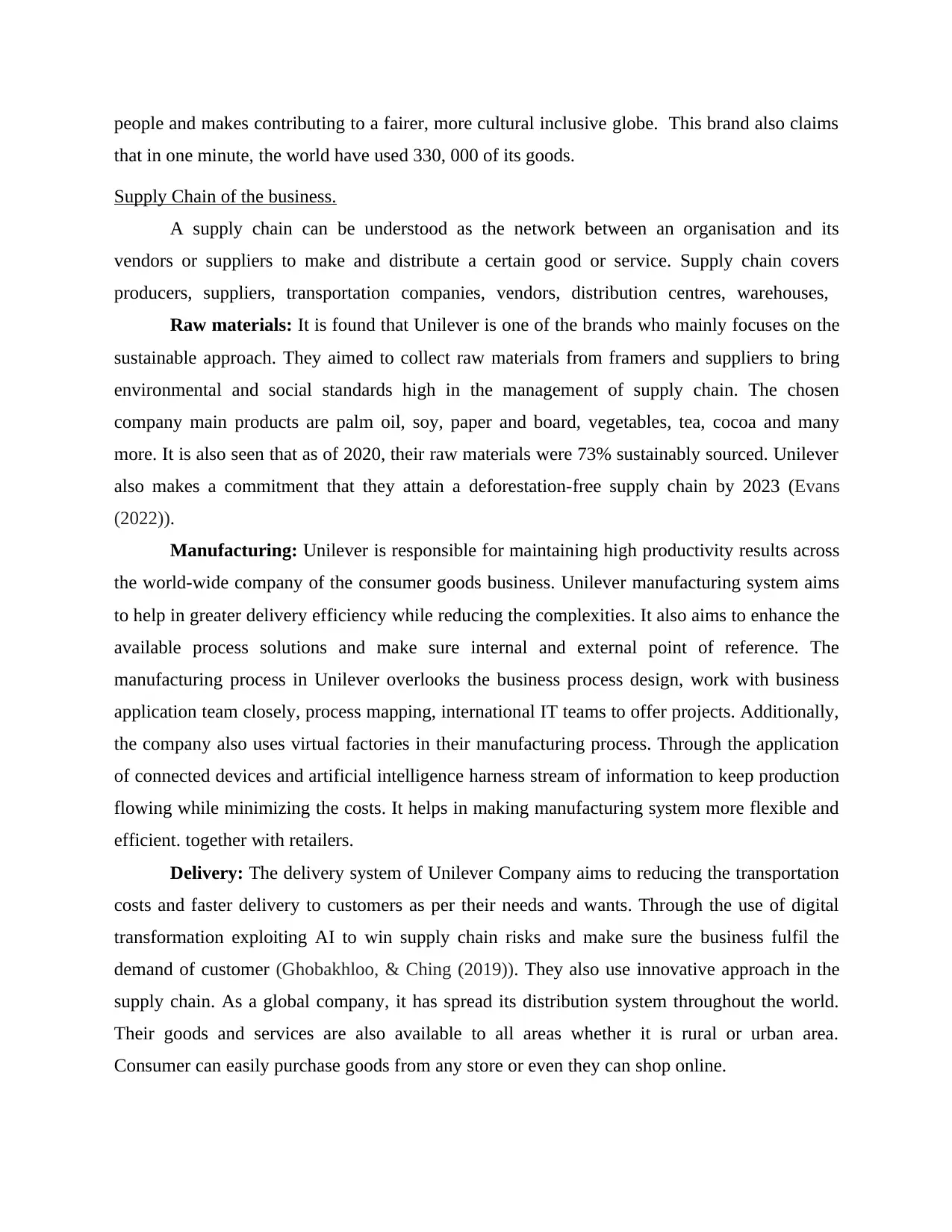
people and makes contributing to a fairer, more cultural inclusive globe. This brand also claims
that in one minute, the world have used 330, 000 of its goods.
Supply Chain of the business.
A supply chain can be understood as the network between an organisation and its
vendors or suppliers to make and distribute a certain good or service. Supply chain covers
producers, suppliers, transportation companies, vendors, distribution centres, warehouses,
Raw materials: It is found that Unilever is one of the brands who mainly focuses on the
sustainable approach. They aimed to collect raw materials from framers and suppliers to bring
environmental and social standards high in the management of supply chain. The chosen
company main products are palm oil, soy, paper and board, vegetables, tea, cocoa and many
more. It is also seen that as of 2020, their raw materials were 73% sustainably sourced. Unilever
also makes a commitment that they attain a deforestation-free supply chain by 2023 (Evans
(2022)).
Manufacturing: Unilever is responsible for maintaining high productivity results across
the world-wide company of the consumer goods business. Unilever manufacturing system aims
to help in greater delivery efficiency while reducing the complexities. It also aims to enhance the
available process solutions and make sure internal and external point of reference. The
manufacturing process in Unilever overlooks the business process design, work with business
application team closely, process mapping, international IT teams to offer projects. Additionally,
the company also uses virtual factories in their manufacturing process. Through the application
of connected devices and artificial intelligence harness stream of information to keep production
flowing while minimizing the costs. It helps in making manufacturing system more flexible and
efficient. together with retailers.
Delivery: The delivery system of Unilever Company aims to reducing the transportation
costs and faster delivery to customers as per their needs and wants. Through the use of digital
transformation exploiting AI to win supply chain risks and make sure the business fulfil the
demand of customer (Ghobakhloo, & Ching (2019)). They also use innovative approach in the
supply chain. As a global company, it has spread its distribution system throughout the world.
Their goods and services are also available to all areas whether it is rural or urban area.
Consumer can easily purchase goods from any store or even they can shop online.
that in one minute, the world have used 330, 000 of its goods.
Supply Chain of the business.
A supply chain can be understood as the network between an organisation and its
vendors or suppliers to make and distribute a certain good or service. Supply chain covers
producers, suppliers, transportation companies, vendors, distribution centres, warehouses,
Raw materials: It is found that Unilever is one of the brands who mainly focuses on the
sustainable approach. They aimed to collect raw materials from framers and suppliers to bring
environmental and social standards high in the management of supply chain. The chosen
company main products are palm oil, soy, paper and board, vegetables, tea, cocoa and many
more. It is also seen that as of 2020, their raw materials were 73% sustainably sourced. Unilever
also makes a commitment that they attain a deforestation-free supply chain by 2023 (Evans
(2022)).
Manufacturing: Unilever is responsible for maintaining high productivity results across
the world-wide company of the consumer goods business. Unilever manufacturing system aims
to help in greater delivery efficiency while reducing the complexities. It also aims to enhance the
available process solutions and make sure internal and external point of reference. The
manufacturing process in Unilever overlooks the business process design, work with business
application team closely, process mapping, international IT teams to offer projects. Additionally,
the company also uses virtual factories in their manufacturing process. Through the application
of connected devices and artificial intelligence harness stream of information to keep production
flowing while minimizing the costs. It helps in making manufacturing system more flexible and
efficient. together with retailers.
Delivery: The delivery system of Unilever Company aims to reducing the transportation
costs and faster delivery to customers as per their needs and wants. Through the use of digital
transformation exploiting AI to win supply chain risks and make sure the business fulfil the
demand of customer (Ghobakhloo, & Ching (2019)). They also use innovative approach in the
supply chain. As a global company, it has spread its distribution system throughout the world.
Their goods and services are also available to all areas whether it is rural or urban area.
Consumer can easily purchase goods from any store or even they can shop online.
Paraphrase This Document
Need a fresh take? Get an instant paraphrase of this document with our AI Paraphraser
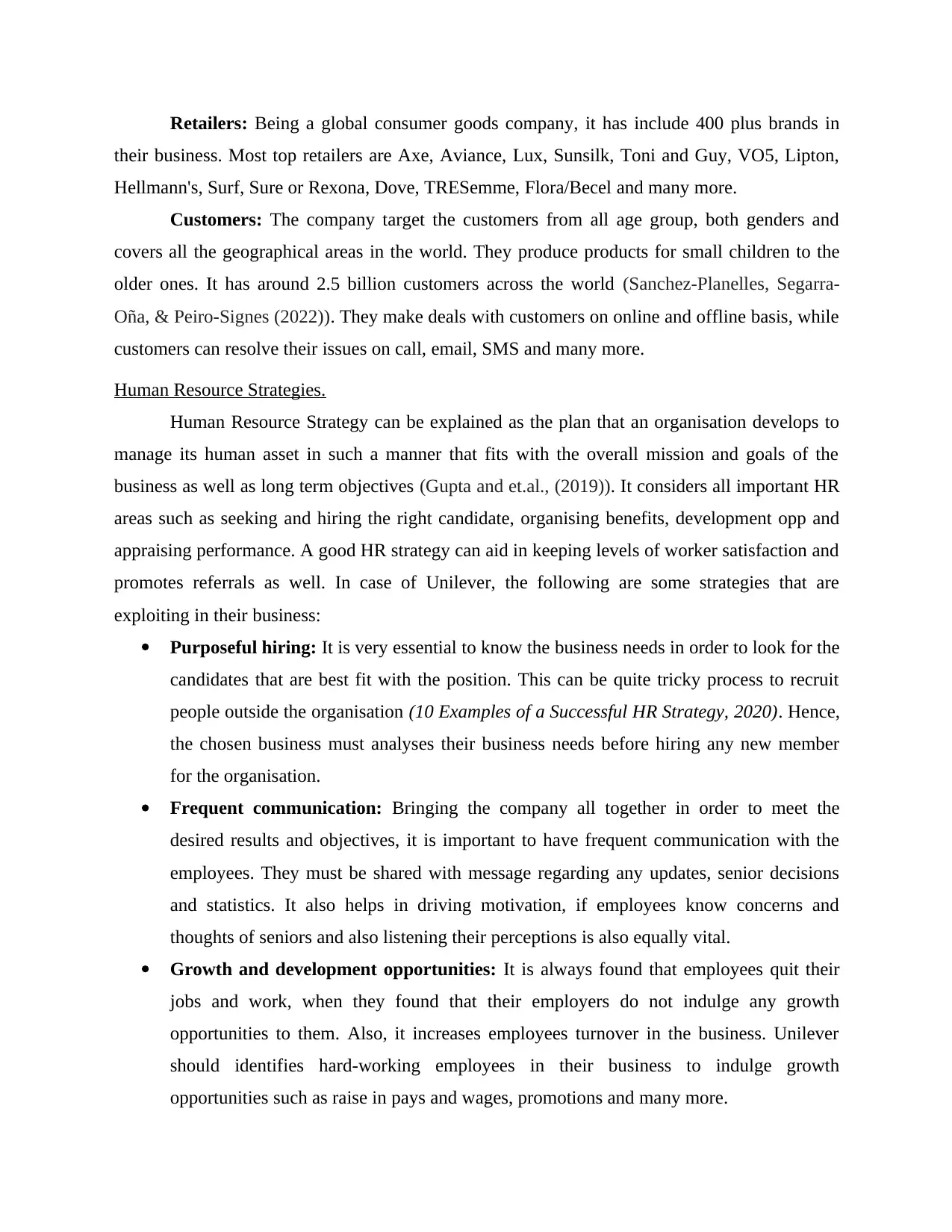
Retailers: Being a global consumer goods company, it has include 400 plus brands in
their business. Most top retailers are Axe, Aviance, Lux, Sunsilk, Toni and Guy, VO5, Lipton,
Hellmann's, Surf, Sure or Rexona, Dove, TRESemme, Flora/Becel and many more.
Customers: The company target the customers from all age group, both genders and
covers all the geographical areas in the world. They produce products for small children to the
older ones. It has around 2.5 billion customers across the world (Sanchez‐Planelles, Segarra‐
Oña, & Peiro‐Signes (2022)). They make deals with customers on online and offline basis, while
customers can resolve their issues on call, email, SMS and many more.
Human Resource Strategies.
Human Resource Strategy can be explained as the plan that an organisation develops to
manage its human asset in such a manner that fits with the overall mission and goals of the
business as well as long term objectives (Gupta and et.al., (2019)). It considers all important HR
areas such as seeking and hiring the right candidate, organising benefits, development opp and
appraising performance. A good HR strategy can aid in keeping levels of worker satisfaction and
promotes referrals as well. In case of Unilever, the following are some strategies that are
exploiting in their business:
Purposeful hiring: It is very essential to know the business needs in order to look for the
candidates that are best fit with the position. This can be quite tricky process to recruit
people outside the organisation (10 Examples of a Successful HR Strategy, 2020). Hence,
the chosen business must analyses their business needs before hiring any new member
for the organisation.
Frequent communication: Bringing the company all together in order to meet the
desired results and objectives, it is important to have frequent communication with the
employees. They must be shared with message regarding any updates, senior decisions
and statistics. It also helps in driving motivation, if employees know concerns and
thoughts of seniors and also listening their perceptions is also equally vital.
Growth and development opportunities: It is always found that employees quit their
jobs and work, when they found that their employers do not indulge any growth
opportunities to them. Also, it increases employees turnover in the business. Unilever
should identifies hard-working employees in their business to indulge growth
opportunities such as raise in pays and wages, promotions and many more.
their business. Most top retailers are Axe, Aviance, Lux, Sunsilk, Toni and Guy, VO5, Lipton,
Hellmann's, Surf, Sure or Rexona, Dove, TRESemme, Flora/Becel and many more.
Customers: The company target the customers from all age group, both genders and
covers all the geographical areas in the world. They produce products for small children to the
older ones. It has around 2.5 billion customers across the world (Sanchez‐Planelles, Segarra‐
Oña, & Peiro‐Signes (2022)). They make deals with customers on online and offline basis, while
customers can resolve their issues on call, email, SMS and many more.
Human Resource Strategies.
Human Resource Strategy can be explained as the plan that an organisation develops to
manage its human asset in such a manner that fits with the overall mission and goals of the
business as well as long term objectives (Gupta and et.al., (2019)). It considers all important HR
areas such as seeking and hiring the right candidate, organising benefits, development opp and
appraising performance. A good HR strategy can aid in keeping levels of worker satisfaction and
promotes referrals as well. In case of Unilever, the following are some strategies that are
exploiting in their business:
Purposeful hiring: It is very essential to know the business needs in order to look for the
candidates that are best fit with the position. This can be quite tricky process to recruit
people outside the organisation (10 Examples of a Successful HR Strategy, 2020). Hence,
the chosen business must analyses their business needs before hiring any new member
for the organisation.
Frequent communication: Bringing the company all together in order to meet the
desired results and objectives, it is important to have frequent communication with the
employees. They must be shared with message regarding any updates, senior decisions
and statistics. It also helps in driving motivation, if employees know concerns and
thoughts of seniors and also listening their perceptions is also equally vital.
Growth and development opportunities: It is always found that employees quit their
jobs and work, when they found that their employers do not indulge any growth
opportunities to them. Also, it increases employees turnover in the business. Unilever
should identifies hard-working employees in their business to indulge growth
opportunities such as raise in pays and wages, promotions and many more.
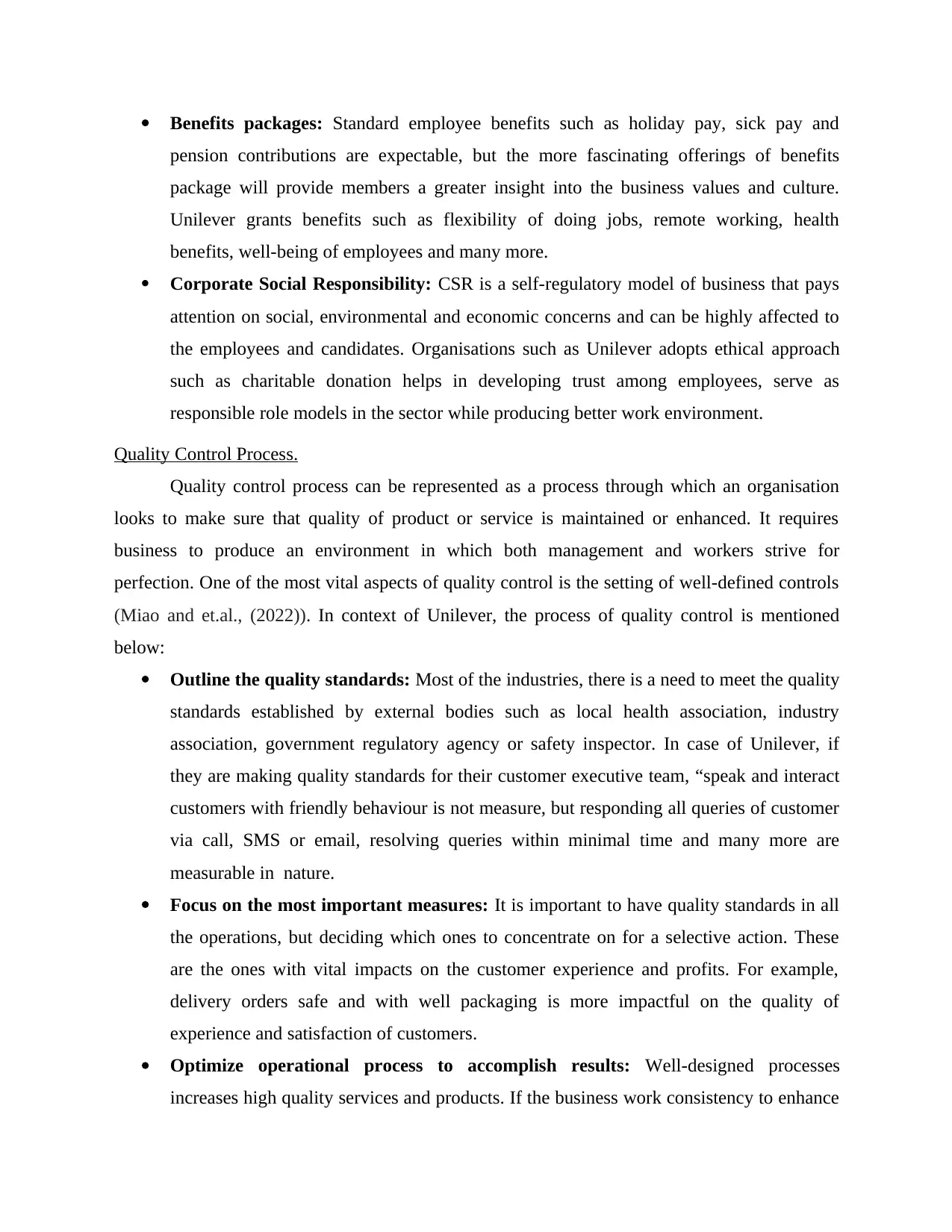
Benefits packages: Standard employee benefits such as holiday pay, sick pay and
pension contributions are expectable, but the more fascinating offerings of benefits
package will provide members a greater insight into the business values and culture.
Unilever grants benefits such as flexibility of doing jobs, remote working, health
benefits, well-being of employees and many more.
Corporate Social Responsibility: CSR is a self-regulatory model of business that pays
attention on social, environmental and economic concerns and can be highly affected to
the employees and candidates. Organisations such as Unilever adopts ethical approach
such as charitable donation helps in developing trust among employees, serve as
responsible role models in the sector while producing better work environment.
Quality Control Process.
Quality control process can be represented as a process through which an organisation
looks to make sure that quality of product or service is maintained or enhanced. It requires
business to produce an environment in which both management and workers strive for
perfection. One of the most vital aspects of quality control is the setting of well-defined controls
(Miao and et.al., (2022)). In context of Unilever, the process of quality control is mentioned
below:
Outline the quality standards: Most of the industries, there is a need to meet the quality
standards established by external bodies such as local health association, industry
association, government regulatory agency or safety inspector. In case of Unilever, if
they are making quality standards for their customer executive team, “speak and interact
customers with friendly behaviour is not measure, but responding all queries of customer
via call, SMS or email, resolving queries within minimal time and many more are
measurable in nature.
Focus on the most important measures: It is important to have quality standards in all
the operations, but deciding which ones to concentrate on for a selective action. These
are the ones with vital impacts on the customer experience and profits. For example,
delivery orders safe and with well packaging is more impactful on the quality of
experience and satisfaction of customers.
Optimize operational process to accomplish results: Well-designed processes
increases high quality services and products. If the business work consistency to enhance
pension contributions are expectable, but the more fascinating offerings of benefits
package will provide members a greater insight into the business values and culture.
Unilever grants benefits such as flexibility of doing jobs, remote working, health
benefits, well-being of employees and many more.
Corporate Social Responsibility: CSR is a self-regulatory model of business that pays
attention on social, environmental and economic concerns and can be highly affected to
the employees and candidates. Organisations such as Unilever adopts ethical approach
such as charitable donation helps in developing trust among employees, serve as
responsible role models in the sector while producing better work environment.
Quality Control Process.
Quality control process can be represented as a process through which an organisation
looks to make sure that quality of product or service is maintained or enhanced. It requires
business to produce an environment in which both management and workers strive for
perfection. One of the most vital aspects of quality control is the setting of well-defined controls
(Miao and et.al., (2022)). In context of Unilever, the process of quality control is mentioned
below:
Outline the quality standards: Most of the industries, there is a need to meet the quality
standards established by external bodies such as local health association, industry
association, government regulatory agency or safety inspector. In case of Unilever, if
they are making quality standards for their customer executive team, “speak and interact
customers with friendly behaviour is not measure, but responding all queries of customer
via call, SMS or email, resolving queries within minimal time and many more are
measurable in nature.
Focus on the most important measures: It is important to have quality standards in all
the operations, but deciding which ones to concentrate on for a selective action. These
are the ones with vital impacts on the customer experience and profits. For example,
delivery orders safe and with well packaging is more impactful on the quality of
experience and satisfaction of customers.
Optimize operational process to accomplish results: Well-designed processes
increases high quality services and products. If the business work consistency to enhance
⊘ This is a preview!⊘
Do you want full access?
Subscribe today to unlock all pages.

Trusted by 1+ million students worldwide
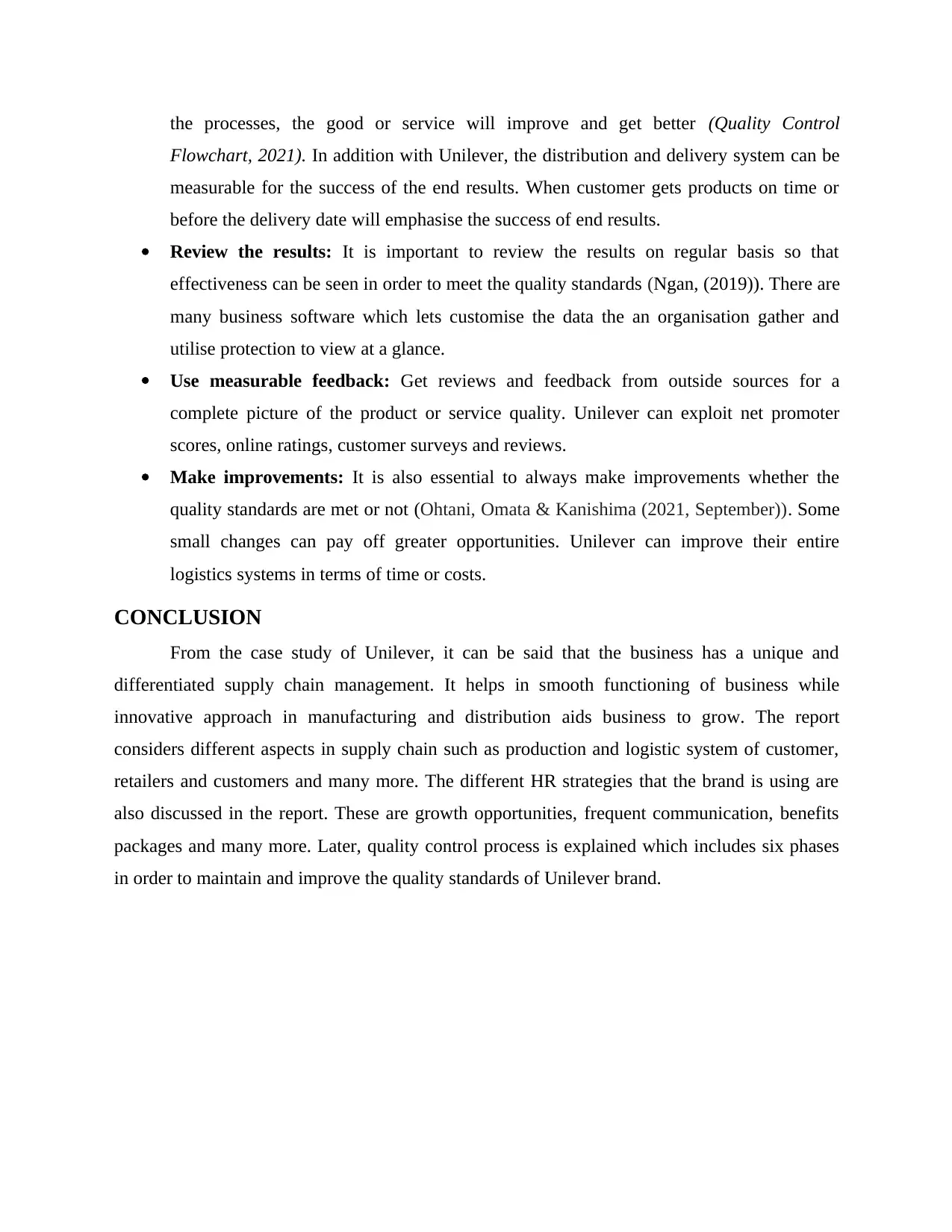
the processes, the good or service will improve and get better (Quality Control
Flowchart, 2021). In addition with Unilever, the distribution and delivery system can be
measurable for the success of the end results. When customer gets products on time or
before the delivery date will emphasise the success of end results.
Review the results: It is important to review the results on regular basis so that
effectiveness can be seen in order to meet the quality standards (Ngan, (2019)). There are
many business software which lets customise the data the an organisation gather and
utilise protection to view at a glance.
Use measurable feedback: Get reviews and feedback from outside sources for a
complete picture of the product or service quality. Unilever can exploit net promoter
scores, online ratings, customer surveys and reviews.
Make improvements: It is also essential to always make improvements whether the
quality standards are met or not (Ohtani, Omata & Kanishima (2021, September)). Some
small changes can pay off greater opportunities. Unilever can improve their entire
logistics systems in terms of time or costs.
CONCLUSION
From the case study of Unilever, it can be said that the business has a unique and
differentiated supply chain management. It helps in smooth functioning of business while
innovative approach in manufacturing and distribution aids business to grow. The report
considers different aspects in supply chain such as production and logistic system of customer,
retailers and customers and many more. The different HR strategies that the brand is using are
also discussed in the report. These are growth opportunities, frequent communication, benefits
packages and many more. Later, quality control process is explained which includes six phases
in order to maintain and improve the quality standards of Unilever brand.
Flowchart, 2021). In addition with Unilever, the distribution and delivery system can be
measurable for the success of the end results. When customer gets products on time or
before the delivery date will emphasise the success of end results.
Review the results: It is important to review the results on regular basis so that
effectiveness can be seen in order to meet the quality standards (Ngan, (2019)). There are
many business software which lets customise the data the an organisation gather and
utilise protection to view at a glance.
Use measurable feedback: Get reviews and feedback from outside sources for a
complete picture of the product or service quality. Unilever can exploit net promoter
scores, online ratings, customer surveys and reviews.
Make improvements: It is also essential to always make improvements whether the
quality standards are met or not (Ohtani, Omata & Kanishima (2021, September)). Some
small changes can pay off greater opportunities. Unilever can improve their entire
logistics systems in terms of time or costs.
CONCLUSION
From the case study of Unilever, it can be said that the business has a unique and
differentiated supply chain management. It helps in smooth functioning of business while
innovative approach in manufacturing and distribution aids business to grow. The report
considers different aspects in supply chain such as production and logistic system of customer,
retailers and customers and many more. The different HR strategies that the brand is using are
also discussed in the report. These are growth opportunities, frequent communication, benefits
packages and many more. Later, quality control process is explained which includes six phases
in order to maintain and improve the quality standards of Unilever brand.
Paraphrase This Document
Need a fresh take? Get an instant paraphrase of this document with our AI Paraphraser
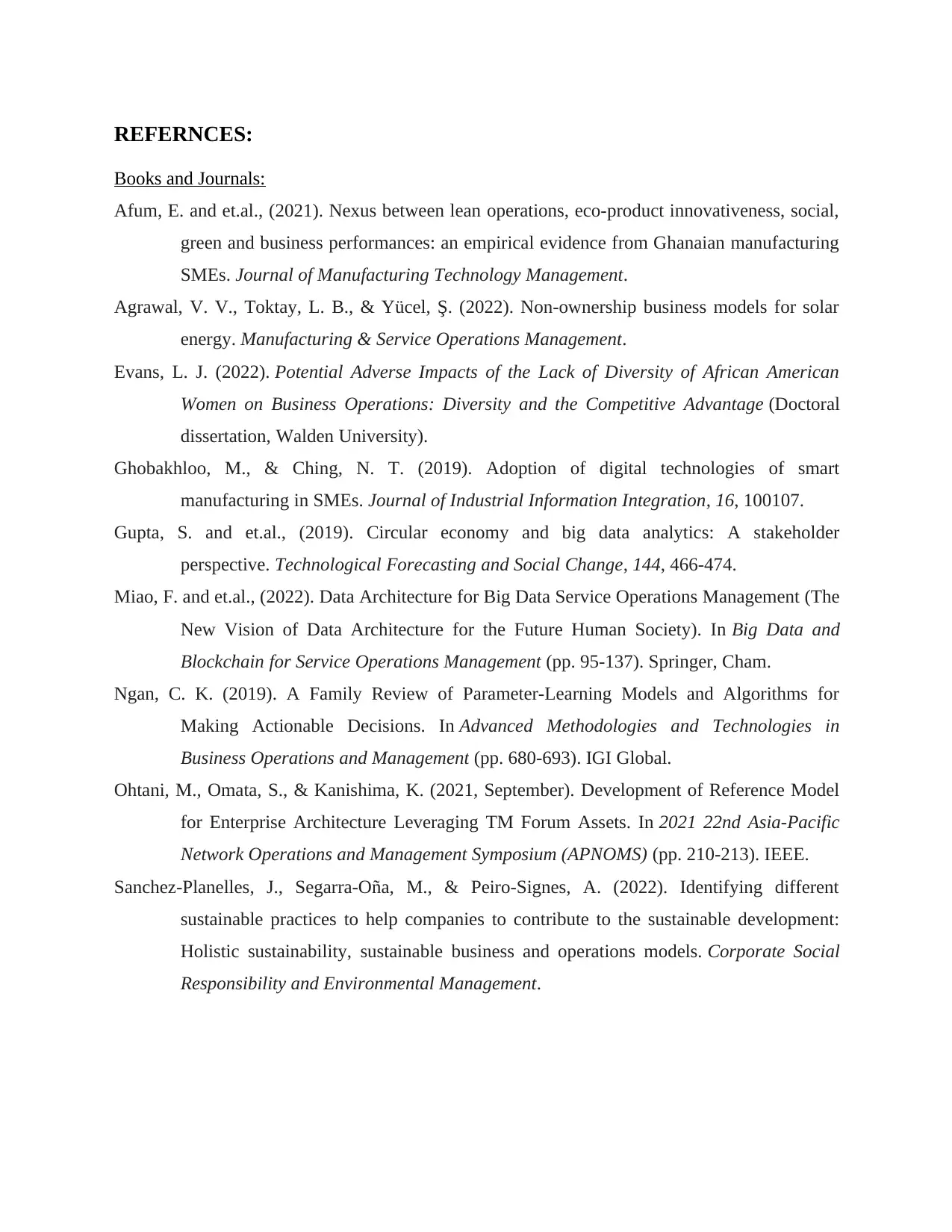
REFERNCES:
Books and Journals:
Afum, E. and et.al., (2021). Nexus between lean operations, eco-product innovativeness, social,
green and business performances: an empirical evidence from Ghanaian manufacturing
SMEs. Journal of Manufacturing Technology Management.
Agrawal, V. V., Toktay, L. B., & Yücel, Ş. (2022). Non-ownership business models for solar
energy. Manufacturing & Service Operations Management.
Evans, L. J. (2022). Potential Adverse Impacts of the Lack of Diversity of African American
Women on Business Operations: Diversity and the Competitive Advantage (Doctoral
dissertation, Walden University).
Ghobakhloo, M., & Ching, N. T. (2019). Adoption of digital technologies of smart
manufacturing in SMEs. Journal of Industrial Information Integration, 16, 100107.
Gupta, S. and et.al., (2019). Circular economy and big data analytics: A stakeholder
perspective. Technological Forecasting and Social Change, 144, 466-474.
Miao, F. and et.al., (2022). Data Architecture for Big Data Service Operations Management (The
New Vision of Data Architecture for the Future Human Society). In Big Data and
Blockchain for Service Operations Management (pp. 95-137). Springer, Cham.
Ngan, C. K. (2019). A Family Review of Parameter-Learning Models and Algorithms for
Making Actionable Decisions. In Advanced Methodologies and Technologies in
Business Operations and Management (pp. 680-693). IGI Global.
Ohtani, M., Omata, S., & Kanishima, K. (2021, September). Development of Reference Model
for Enterprise Architecture Leveraging TM Forum Assets. In 2021 22nd Asia-Pacific
Network Operations and Management Symposium (APNOMS) (pp. 210-213). IEEE.
Sanchez‐Planelles, J., Segarra‐Oña, M., & Peiro‐Signes, A. (2022). Identifying different
sustainable practices to help companies to contribute to the sustainable development:
Holistic sustainability, sustainable business and operations models. Corporate Social
Responsibility and Environmental Management.
Books and Journals:
Afum, E. and et.al., (2021). Nexus between lean operations, eco-product innovativeness, social,
green and business performances: an empirical evidence from Ghanaian manufacturing
SMEs. Journal of Manufacturing Technology Management.
Agrawal, V. V., Toktay, L. B., & Yücel, Ş. (2022). Non-ownership business models for solar
energy. Manufacturing & Service Operations Management.
Evans, L. J. (2022). Potential Adverse Impacts of the Lack of Diversity of African American
Women on Business Operations: Diversity and the Competitive Advantage (Doctoral
dissertation, Walden University).
Ghobakhloo, M., & Ching, N. T. (2019). Adoption of digital technologies of smart
manufacturing in SMEs. Journal of Industrial Information Integration, 16, 100107.
Gupta, S. and et.al., (2019). Circular economy and big data analytics: A stakeholder
perspective. Technological Forecasting and Social Change, 144, 466-474.
Miao, F. and et.al., (2022). Data Architecture for Big Data Service Operations Management (The
New Vision of Data Architecture for the Future Human Society). In Big Data and
Blockchain for Service Operations Management (pp. 95-137). Springer, Cham.
Ngan, C. K. (2019). A Family Review of Parameter-Learning Models and Algorithms for
Making Actionable Decisions. In Advanced Methodologies and Technologies in
Business Operations and Management (pp. 680-693). IGI Global.
Ohtani, M., Omata, S., & Kanishima, K. (2021, September). Development of Reference Model
for Enterprise Architecture Leveraging TM Forum Assets. In 2021 22nd Asia-Pacific
Network Operations and Management Symposium (APNOMS) (pp. 210-213). IEEE.
Sanchez‐Planelles, J., Segarra‐Oña, M., & Peiro‐Signes, A. (2022). Identifying different
sustainable practices to help companies to contribute to the sustainable development:
Holistic sustainability, sustainable business and operations models. Corporate Social
Responsibility and Environmental Management.
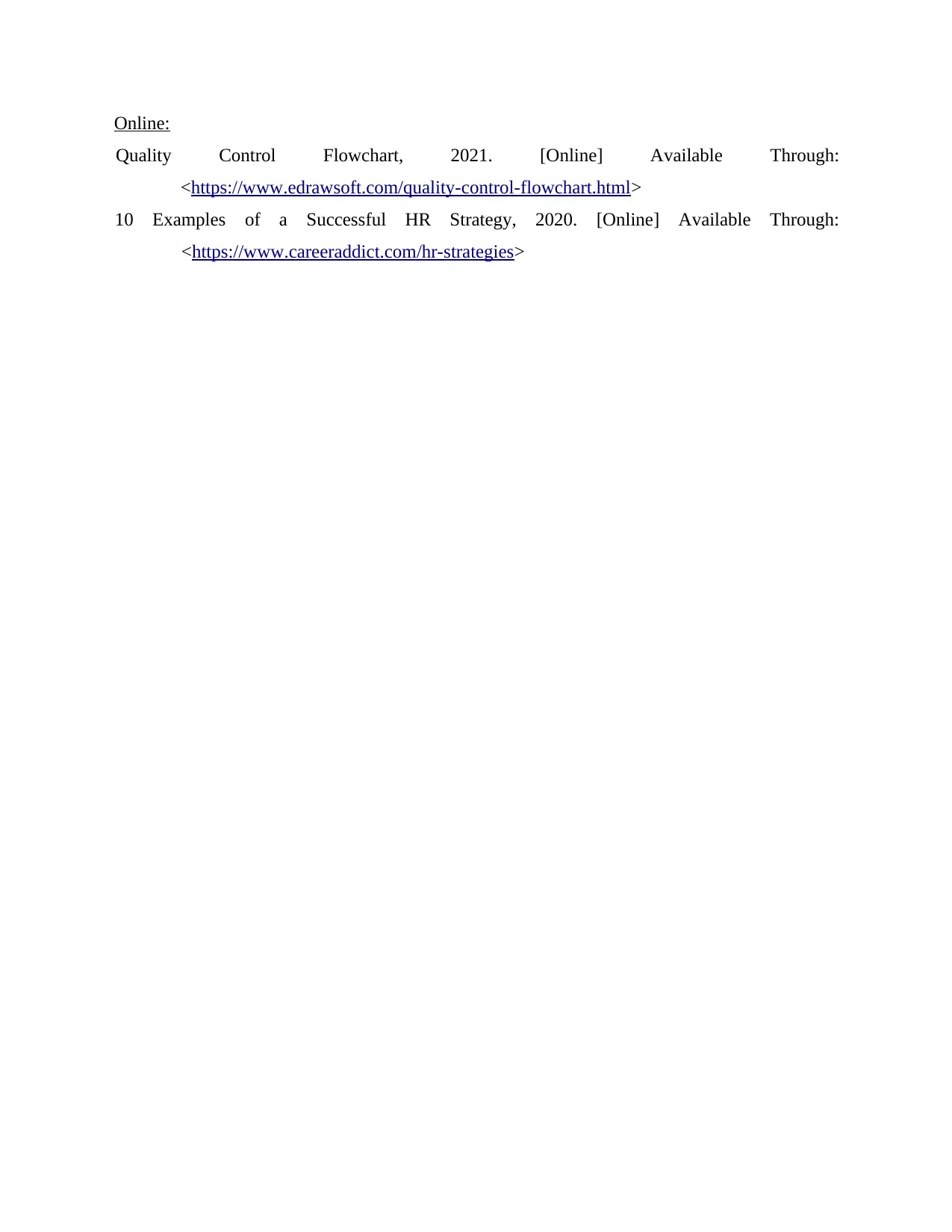
Online:
Quality Control Flowchart, 2021. [Online] Available Through:
<https://www.edrawsoft.com/quality-control-flowchart.html>
10 Examples of a Successful HR Strategy, 2020. [Online] Available Through:
<https://www.careeraddict.com/hr-strategies>
Quality Control Flowchart, 2021. [Online] Available Through:
<https://www.edrawsoft.com/quality-control-flowchart.html>
10 Examples of a Successful HR Strategy, 2020. [Online] Available Through:
<https://www.careeraddict.com/hr-strategies>
⊘ This is a preview!⊘
Do you want full access?
Subscribe today to unlock all pages.

Trusted by 1+ million students worldwide
1 out of 9
Related Documents
Your All-in-One AI-Powered Toolkit for Academic Success.
+13062052269
info@desklib.com
Available 24*7 on WhatsApp / Email
![[object Object]](/_next/static/media/star-bottom.7253800d.svg)
Unlock your academic potential
Copyright © 2020–2025 A2Z Services. All Rights Reserved. Developed and managed by ZUCOL.




